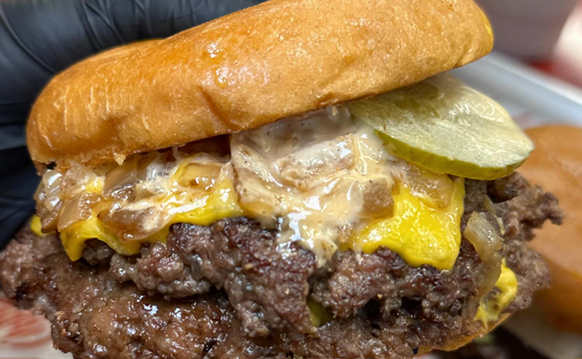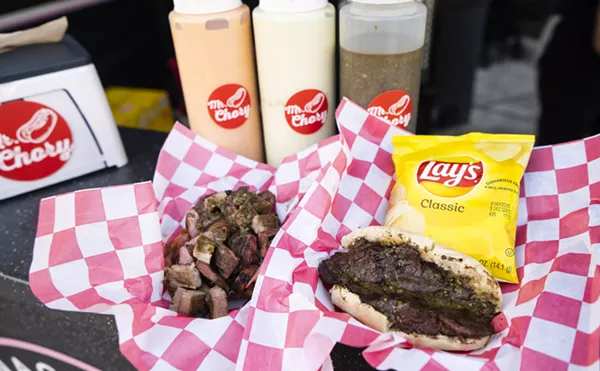The brainchild of RARE Hospitality Intl. Inc. in Atlanta, the first Capital Grille opened in Providence, Rhode Island, in July 1990 to great fanfare -- and to the happy-hour joy of Vincent "Buddy" Cianci, Providence's then-famously charming and corrupt mayor, who loved to have cocktails at the bar.
After Providence came 18 other Grilles hugging the East Coast in hubs such as Boston, Philadelphia, Charlotte, and Atlanta, then working their way to Minneapolis, Chicago, Houston, and Detroit, and slowly pushing westward into Denver and Phoenix.
This is not to say the Grille doesn't have well-trained service, strategically rewarding food, and a mahogany-and-linen atmosphere that equals ambiance. Or even that its 14-year progress across the country hasn't collected kudos wherever branches have opened. Yet the lightning flashes that come with memorable dining are dimmed slightly here by a scrim of caution.
The specialty is beef, specifically steaks, and more specifically, dry-aged steaks of every cut known to man and cow. What does dry-aged mean? Basically, controlled rotting. The meat is hung on a wire rack in a monitored, refrigerated environment at a temperature of 32 to 36 degrees. (The Grille does its dry-aging on the premises.)
Why make such a fuss about dry-aging? It (a) requires the best quality of well-marbled meat and (b) it's damnably expensive.
So, think of the tag "dry-aged" as bragging rights among the steakhouse crowd. Ruth's Chris custom ages and Morton's the Steakhouse in Palm Beach and Boca Raton prime ages theirs. But both Gallagher's Steakhouse and Smith & Wollensky in Miami Beach make a point of saying they dry-age too.
And is dry-aged steak worth paying up to $36 per cut for the larger sizes? At the Capital Grille, the answer is yes. Someone in the kitchen has learned the difference between "medium" and "medium rare." Chefs Rob Lewis and Carmine Decandia know that the highest-quality U.S. prime beef doesn't need much preparation beyond the right degree of heat (in this case, searing) and a talent for timing. Whether it's a 24-ounce Porterhouse ($35.95), whose juiciness and spot-on tenderness saves you from making the tough choice between a sirloin or a filet, or a 22-ounce Delmonico ($32.95), whose bone-in rib-eye flavor lends its own validity to the lo-carb craze, the Grille's steaks succeed under any sort of scrutiny. Take your pick -- you won't go wrong. Or hungry.
Helping the beef go down smoothly are more than 400 varieties of wine, with an emphasis on European and California reds, on a list almost as long as Clinton's autobiography.
The kitchen's skills with meat may also be why the larger pieces of beef, gluttonous (and unhealthy) in any other context, seem like logical portions here. They overwhelm the understandable urge for such un-hoof-y but equally piggish choices as one of the two- to five-pound lobsters (market price) or the fresh-seared salmon with dill Dijon mustard sauce ($24.95).
Since these steaks anchor the entrée selections with the security of the battleship anchoring a fleet, the dinner (and lunch) menu can proceed into the other areas of the meal without too much worry.
This confidence also comes from a sharp, chain-worthy sense of playing it safe. Consider the worthy appetizers. Choices run the gamut from a classic $11.95 jumbo shrimp cocktail that Mamie Eisenhower would have understood to an even more classic smoked Norwegian salmon (appetizers are $11 to $13). The steak tartare ($12.95), though beautifully presented with the right mix of food accessories, was a popular choice at most country clubs in the 1950s. The blue cheese and bacon chunks that dress the wedge of iceberg lettuce salad taste superb, but they are still atop iceberg lettuce.
The $4.95 to $7.95 side dishes summon the same mix of salutes and snores. Well-rendered dishes such as fresh asparagus with Hollandaise, fresh creamed spinach, and potatoes lyonnaise bring back menu memories of the years when Cuba was just another place to go on vacation. (Actually, circa 1915, potatoes lyonnaise was my grandmother's favorite side dish.)
The desserts ($4 to $7) end a Capital Grille meal nicely, although with no more uniqueness. Skip such staples as key lime pie, coconut cream pie, and white chocolate mousse and go for the Fresh Strawberries Capital Grille, with the fruit drowned in vanilla ice cream and a sauce of port and Grand Marnier.
This last choice brings up a second issue. Besides the emphasis on safe classics, the extraordinary number of "signature" dishes draws attention to the chain's peculiar idea of originality. The actual dishes such as the Grille's Delmonico, signature veal chop, steak tartare, and fresh vegetables hardly bear their attention-getting nomenclature. While dining companions have pronounced these selections as among the best they have ever tasted, the recipes are unique neither in themselves nor in their preparation.
Some of this problem of reduced expectations has to do with the descriptions of the food on the menu, which often read as if some copywriter with a well-developed sense of irony (or parody) had taken a few tokes and then sat down at the computer. The Roquefort butter is "wondrous." The tuna Mediterranean is a "delightful affair." The flourless chocolate espresso cake is worth "rhapsodizing" over. You'll be "enormously satisfied" with the lobster. Isn't "satisfied" enough? If the food being described weren't so good, you might hurl.
Moments to remember from recent trips to the Capital Grille? Biting into the first of many pan-fried calamari with hot cherry peppers ($10.95), an appetizer whose balance of flavors and perfect scrunchiness of mollusk deserves a handful of stars. Being served by the warmly professional Giselle, a waitress who knows that absence doesn't make the heart grow fonder yet that familiarity can breed a bad tip. Eavesdropping on a story about the time a neighboring diner met Naomi Campbell on a plane and listened with fascination as the model described her just-finished "interview" with Fidel Castro. Shamelessly following a forkful of medium-rare 14-ounce steak au poivre ($32.95) topped by a smoothly blended Courvoisier cream and peppercorn sauce with a generous mouthful of Sam's mashed potatoes, and then following that with a swallow of a superb pinot noir. Finishing every ounce of a 24-ounce porterhouse steak and feeling terribly good about the world.
The Capital Grille may be a chain and its singular joys imperiled by all the cloning. But because of its national clout and consistently excellent delivery, the restaurant has already claimed its own local fan base, with word of mouth that can be heard among all the steak-house competition from Christy's in Coral Gables to Morton's the Steakhouse in West Palm Beach. Welcome to the neighborhood.











